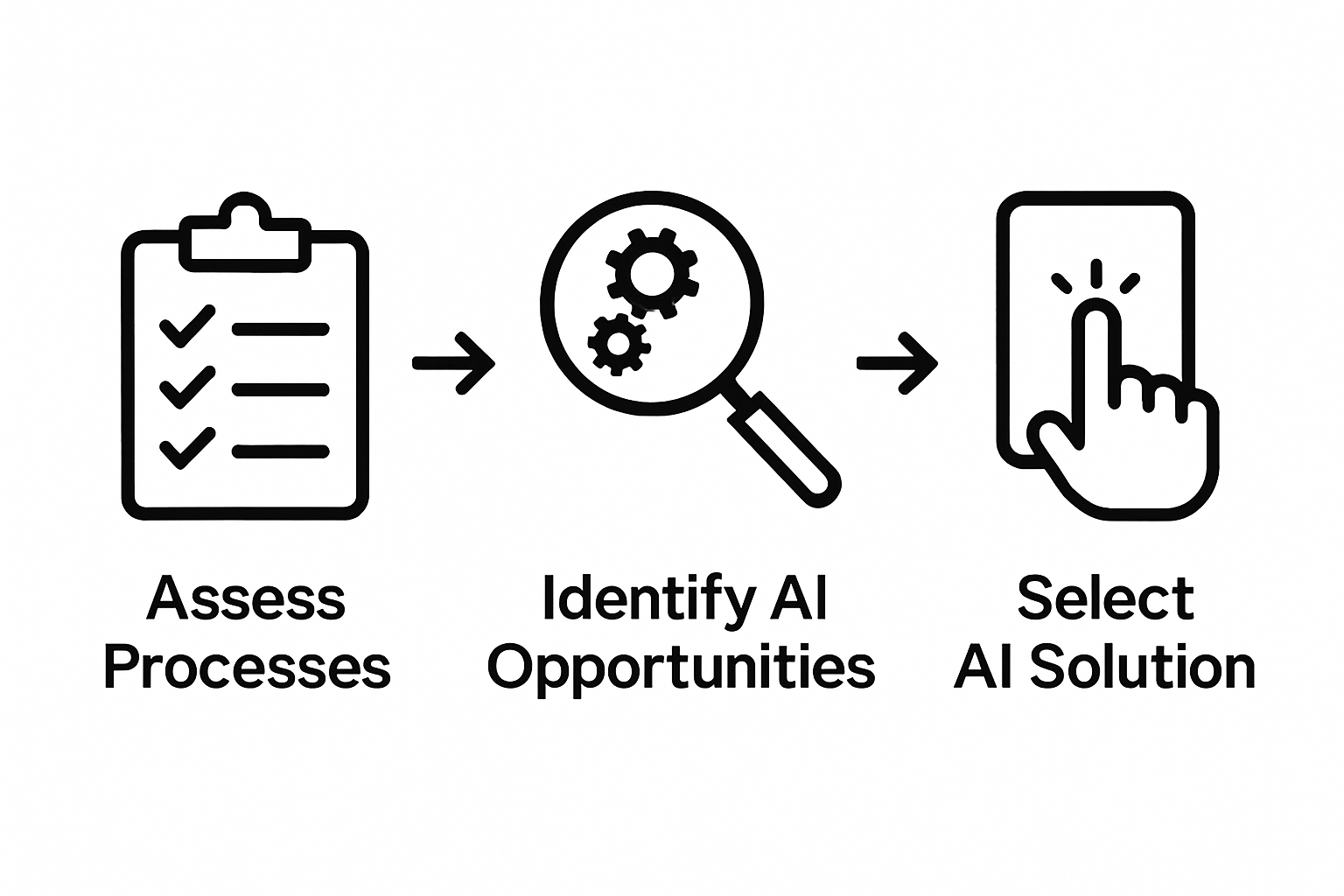How to Scale Business with AI: A Step-by-Step Guide

Most business owners want to scale faster but get tripped up by messy workflows and endless manual tasks. Here is the wild part. According to PwC, proper AI adoption can boost business productivity by up to 40 percent, yet most companies waste months guessing where to start. The real secret is that you do not need a giant budget or a data science team. Smart, easy steps can put the power of AI in your hands right now.
Table of Contents
- Step 1: Assess Your Current Business Processes
- Step 2: Identify AI Opportunities For Automation
- Step 3: Select The Right AI Tools And Solutions
- Step 4: Implement AI Solutions In Stages
- Step 5: Monitor AI Performance And Make Adjustments
- Step 6: Evaluate Business Growth And ROI
Quick Summary
| Key Point | Explanation |
|---|---|
| 1. Systematically assess current processes | Conduct a thorough audit of workflows to identify opportunities for AI integration. Understand your operational landscape clearly. |
| 2. Prioritize AI automation opportunities | Classify tasks into high, medium, and low potential for automation based on impact and complexity. Focus on high-impact areas first. |
| 3. Select suitable AI tools carefully | Choose AI solutions that align with specific needs, ensuring compatibility, scalability, and ease of integration with existing systems. |
| 4. Implement AI solutions in stages | Start with pilot programs to test AI effectiveness before full deployment, gathering insights and adjusting based on performance. |
| 5. Continuously monitor and evaluate AI performance | Establish a framework for tracking metrics and making necessary adjustments to ensure AI tools meet evolving business needs. |
Step 1: Assess Your Current Business Processes
Successfully scaling your business with AI begins with a thorough understanding of your existing operational landscape. This critical first step involves systematically examining your current business processes to identify precise opportunities for AI integration. Business owners must approach this assessment with strategic clarity and precision.
To begin, gather your core team and conduct a comprehensive workflow audit. Map out every significant business process across departments, paying special attention to repetitive tasks, data entry activities, customer interactions, and administrative functions. Learn more about strategic AI adoption with our detailed guide on transforming business operations.
Focus on identifying processes characterized by high volume, consistent patterns, and minimal variability. These characteristics make tasks ideal candidates for AI automation. Look for activities consuming significant human time that follow predictable sequences: invoice processing, customer support ticket routing, scheduling, reporting, and data reconciliation.
While reviewing processes, evaluate each task through three critical lenses: frequency, complexity, and strategic value. Processes executed multiple times daily with standardized steps represent prime AI integration targets. Simultaneously, consider the potential impact on team productivity and overall business efficiency. Not every repeatable task warrants immediate AI intervention.
The table below summarizes key criteria to help you prioritize which business processes are suitable for AI automation.
| Criteria | Description | Example Tasks |
|---|---|---|
| Frequency | How often the task is performed | Daily data entry, frequent ticket routing |
| Complexity | Degree of standardization and predictability | Standardized scheduling, invoice processing |
| Strategic Value | Potential to impact business efficiency or productivity | Reporting, customer interaction management |
| Human Judgment Requirement | Extent to which complex decisions are involved | Low for structured, rule-based processes |
| Quantifiable Performance Metrics | Ability to measure current process results and improvements | Task completion time, error rates |
| Time or Cost Savings Potential | Estimated resource recovery if automated | Staff hours saved, operational cost reduced |
Document your findings meticulously. Create a detailed process inventory that includes:
- Task description
- Current manual time investment
- Complexity level
- Potential automation potential
- Estimated efficiency gains
This systematic assessment provides a strategic roadmap for targeted AI implementation.

By understanding your operational nuances, you transform AI from an abstract concept into a precise business enhancement tool. Your goal is not wholesale replacement but strategic augmentation of human capabilities.
Successful completion of this step means having a clear, documented overview of processes ripe for AI integration, supported by quantifiable metrics that justify technological investment.
Step 2: Identify AI Opportunities for Automation
With your business processes meticulously mapped, the next strategic phase involves pinpointing precise AI automation opportunities that deliver tangible value. Successful AI integration is not about replacing humans but empowering them through intelligent technological augmentation. Discover strategic AI opportunities for your specific business context.
According to research from PwC, organizations should prioritize automation opportunities that generate measurable business outcomes. Begin by categorizing your previously documented processes into three strategic tiers: high-impact, medium-potential, and low-complexity automation candidates.
High-impact opportunities typically involve tasks consuming significant human time, containing repetitive structured steps, and directly influencing operational efficiency. Examples include customer support ticket routing, data entry and reconciliation, inventory management, financial reporting, and scheduling. These processes represent your initial AI automation targets, offering immediate productivity gains and cost reductions.
Medium-potential opportunities require more nuanced evaluation. These tasks might involve moderate complexity or occasional variability. Customer interaction logging, preliminary screening processes, basic data analysis, and preliminary document processing fall into this category. Such opportunities demand careful assessment to ensure AI tools can handle subtle contextual variations.
When evaluating potential AI automation candidates, consider these critical criteria:
- Consistent and predictable workflow patterns
- Clear input and output parameters
- Quantifiable performance metrics
- Minimal requirement for complex human judgment
- Potential for significant time or cost savings
Remember that AI implementation is not a one-size-fits-all solution. Each business requires a tailored approach that respects existing workflows and team dynamics. Your goal is strategic enhancement, not wholesale disruption.
This table provides an at-a-glance overview of each main step for scaling your business with AI, highlighting the core activity and desired outcome at every stage.
| Step | Main Activity | Key Outcome |
|---|---|---|
| Assess Current Business Processes | Audit workflows and document task inventory | Clear identification of automation candidates |
| Identify AI Opportunities for Automation | Prioritize high-impact automation targets | Prioritized list of AI automation options |
| Select the Right AI Tools and Solutions | Evaluate and shortlist suitable AI tools | Best-fit solutions selected for your needs |
| Implement AI Solutions in Stages | Launch and monitor pilot implementations | Proven, low-risk adoption of AI technologies |
| Monitor AI Performance and Make Adjustments | Track KPIs and gather feedback | Ongoing performance improvement |
| Evaluate Business Growth and ROI | Measure results and strategic impact | Data-driven assessment of AI investment |
Successful completion of this step means developing a prioritized list of AI automation opportunities, ranked by potential impact, complexity, and strategic alignment with your business objectives.
Step 3: Select the Right AI Tools and Solutions
Navigating the complex landscape of AI tools requires a strategic approach that aligns technological capabilities with your specific business needs. Selecting the right AI solutions is about finding precise matches for your identified automation opportunities, not chasing the latest technological trends. Learn more about strategic AI tool selection to refine your approach.
The market offers a diverse array of AI tools, each designed to address specific business challenges. Your selection process must prioritize compatibility, scalability, and ease of integration with existing systems. Begin by creating a comprehensive evaluation framework that assesses potential AI solutions across multiple critical dimensions.
Consider tools that offer robust API connectivity, allowing seamless integration with your current technology stack. Look for solutions that provide flexible customization options, enabling you to tailor AI functionalities to your unique operational requirements. Prioritize platforms with strong security protocols and clear data governance frameworks to protect your business’s sensitive information.
When evaluating AI tools, conduct thorough demonstrations and pilot tests. Request detailed performance metrics, case studies from similar businesses in your industry, and comprehensive documentation about implementation processes. Pay close attention to vendor support capabilities, training resources, and ongoing technical assistance. A tool’s long-term value extends far beyond its initial price point.
Key evaluation criteria for selecting AI tools should include:
- Alignment with specific automation opportunities
- Scalability and future growth potential
- Integration complexity with existing systems
- Total cost of ownership
- Vendor reputation and track record
- Customization and flexibility
- Security and compliance features
Remember that successful AI tool selection is not a standalone decision but a collaborative process involving key stakeholders across your organization. Engage your technical teams, operational managers, and frontline employees to gather comprehensive insights and build collective buy-in for technological transformation.
Successful completion of this step means developing a shortlist of AI tools that precisely match your business’s identified automation opportunities, supported by rigorous evaluation and preliminary implementation planning.
Step 4: Implement AI Solutions in Stages
Successful AI integration demands a measured, strategic approach that minimizes risk and maximizes organizational learning. Staged implementation allows businesses to test, refine, and validate AI solutions before full-scale deployment. Learn how AI can future-proof your business through thoughtful technological transformation.
According to research from McKinsey & Company, phased implementation beginning with pilot programs enables organizations to demonstrate quick wins and iteratively improve technological integrations.
Begin with a carefully selected pilot project that represents a low-risk, high-visibility opportunity from your previously identified automation candidates. This initial implementation serves as a critical proof of concept, allowing your team to understand AI capabilities, address potential challenges, and build organizational confidence.
Develop a comprehensive pilot implementation plan that includes clear objectives, precise success metrics, resource allocation, and a defined timeline. Select a process with well-documented workflows, measurable outcomes, and minimal potential for significant operational disruption. Customer support ticket routing or standardized data entry processes often serve as excellent initial AI integration points.
Establish a dedicated cross-functional team responsible for pilot execution. This group should include representatives from operations, technology, and specific business units directly impacted by the AI solution. Their diverse perspectives will ensure holistic implementation and help identify potential adaptation challenges early in the process.
Key implementation stages include:
- Configuring and testing AI tool in controlled environment
- Training team members on new technological workflows
- Monitoring initial performance and collecting comprehensive data
- Documenting unexpected challenges or performance variations
- Gathering feedback from direct users and stakeholders
Maintain transparent communication throughout the pilot. Regular check-ins and detailed performance tracking will help your team understand the AI tool’s real-world effectiveness. Be prepared to make rapid adjustments based on emerging insights.
Successful completion of this step means having a thoroughly documented pilot implementation with clear performance metrics, team feedback, and a strategic plan for potential broader organizational deployment.
Step 5: Monitor AI Performance and Make Adjustments
Continuous performance monitoring transforms AI from a static tool into a dynamic, evolving business asset. Effective AI integration requires ongoing assessment, refinement, and strategic recalibration. Explore advanced AI performance tracking strategies to optimize your technological investments.
Establish a robust monitoring framework that captures comprehensive performance metrics across multiple dimensions. This approach goes beyond simple output measurements, diving deep into qualitative and quantitative indicators that reveal the true impact of your AI implementation.
Develop a specialized dashboard that tracks key performance indicators (KPIs) specific to your AI-automated processes. These metrics should include accuracy rates, processing speed, error reduction percentages, and direct productivity gains. Quantify the human time saved and financial value generated by your AI solutions, transforming abstract technological implementation into concrete business value.
Create a continuous feedback loop involving team members directly interacting with AI tools. Their frontline insights often reveal nuanced performance characteristics that raw data might miss. Implement regular quarterly review sessions where operational teams can share detailed observations, challenges, and potential improvement strategies.
Key performance monitoring elements include:
- Accuracy and error rate tracking
- Processing time comparisons
- Cost savings calculations
- Team productivity metrics
- User satisfaction ratings
- Compliance and quality control indicators
Remember that AI performance monitoring is not about achieving perfection but pursuing continuous improvement. Be prepared to make incremental adjustments based on emerging insights. Some variations might require minor configuration tweaks, while others could signal the need for more comprehensive tool recalibration or potential replacement.
Develop a structured adjustment protocol that outlines clear thresholds for performance intervention. Define specific trigger points that warrant immediate review: significant accuracy drops, unexpected processing delays, or consistent user frustration. This proactive approach ensures your AI solutions remain aligned with evolving business requirements.

Successful completion of this step means establishing a dynamic, responsive monitoring system that transforms AI from a technological experiment into a strategic, adaptable business enhancement mechanism.
Step 6: Evaluate Business Growth and ROI
Evaluating the true impact of AI integration goes beyond simple performance metrics, requiring a comprehensive analysis of strategic business growth and return on investment. Transforming technological implementation into measurable business value demands a holistic, multidimensional assessment approach. Discover strategic insights for AI investment evaluation to maximize your technological transformation.
Begin by establishing a comprehensive baseline that captures your business’s performance prior to AI implementation. This historical data serves as a critical reference point, enabling precise measurement of technological impact across operational, financial, and strategic dimensions.
Financial ROI represents only one facet of your AI investment evaluation. While cost savings and productivity gains are important, truly transformative AI integration delivers broader organizational benefits. Consider measuring improvements in employee satisfaction, customer experience quality, innovation capacity, and competitive positioning alongside traditional financial metrics.
Develop a sophisticated evaluation framework that tracks both quantitative and qualitative performance indicators. Quantitative metrics might include processing time reductions, error rate decreases, and direct cost savings. Qualitative assessments could encompass team creativity enhancement, strategic decision-making acceleration, and overall organizational adaptability.
Key ROI evaluation dimensions include:
- Direct cost savings from automation
- Productivity time recovered
- Error reduction percentages
- Customer satisfaction improvements
- Employee engagement and workflow satisfaction
- Innovation acceleration metrics
- Competitive market positioning changes
Implement a rigorous quarterly review process that goes beyond surface-level performance tracking. These comprehensive assessments should involve cross-functional leadership, ensuring a holistic perspective that captures nuanced technological impact across different organizational domains.
Remember that AI investment evaluation is an ongoing journey, not a destination. Be prepared to recalibrate your assessment approach as your technological capabilities and business landscape evolve. Maintain flexibility and openness to redefining success metrics based on emerging insights and strategic priorities.
Successful completion of this step means developing a dynamic, multifaceted evaluation framework that transforms AI from a technological experiment into a strategic business growth catalyst.
Take Strategic Control of Your AI Journey
Struggling to translate AI potential into measurable results for your business? Many growing companies feel overwhelmed by the complexity of identifying where to start, selecting the right tools, and ensuring real returns on AI investments. The steps outlined in our guide highlight how crucial it is to audit processes, prioritize automation, and keep your team involved every step of the way. Yet, even with clear instructions, it’s easy to feel lost when facing technical jargon and the pressure to deliver impactful change.

You do not have to navigate the AI transformation alone. At Average Robot, we work side by side with business owners to build tailored AI roadmaps that align with your operational goals. From hands-on automation to change management support, our team guides you through every stage, helping you avoid costly trial and error. Discover how you can simplify AI adoption for your entire organization and turn automation into a real advantage by visiting our landing page. If you are ready to transform insights from our step-by-step guide into actionable results, take the next step with experts who speak your language. Act now to give your business the competitive edge it deserves.
Frequently Asked Questions
How can I assess my current business processes for AI integration?
To assess your current business processes, conduct a comprehensive workflow audit with your core team. Map out significant processes, focusing on repetitive tasks, data entry, customer interactions, and administrative functions. Evaluate each task based on frequency, complexity, and strategic value to identify suitable candidates for AI integration.
What types of business processes are ideal for AI automation?
Ideal business processes for AI automation typically exhibit high volume, consistent patterns, and minimal variability. Examples include customer support ticket routing, invoice processing, scheduling, and data reconciliation. These tasks consume considerable human time and follow predictable sequences, making them prime candidates for automation.
How should I select AI tools for my business needs?
When selecting AI tools, prioritize compatibility with your existing systems and scalability for future growth. Assess tools based on their ability to integrate, customize to your operational requirements, and provide adequate security features. Conduct thorough demonstrations and request performance metrics to support your selection.
What steps should I take to monitor the performance of AI solutions?
Establish a robust performance monitoring framework that tracks key performance indicators (KPIs) relevant to your AI-automated processes. Use a specialized dashboard to monitor metrics like accuracy rates, processing speeds, and productivity gains. Implement a feedback loop with users to collect insights for ongoing improvement.




